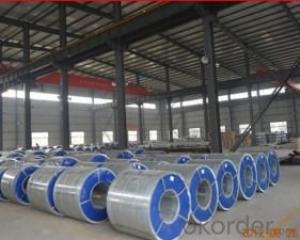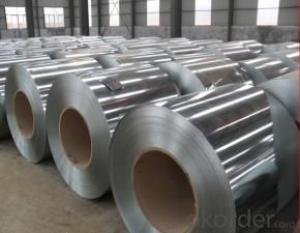Hot Dipped Galvanized Steel Coils for Building Material
- Loading Port:
- Shanghai
- Payment Terms:
- TT OR LC
- Min Order Qty:
- 30 m.t.
- Supply Capability:
- 10000 m.t./month
OKorder Service Pledge
OKorder Financial Service
You Might Also Like
Basic Info.
Model NO.:Hot Dipped Galvanized Steel Coil
Surface Treatment:Galvanized
Certification:ISO, SGS, BV, RoHS, IBR
Technique:Cold Rolled
Standard:ASTM, JIS, GB, AISI, DIN, BS
Application:Roofing, Wall, Corrugated, Structure...
Edge:Mill
Stock:Stock
Steel Grade:Dx51d, SPCC, SGCC, CGCC, S350gd
Name:Hot Dipped Galvanized Steel Coil
Thickness:0.14-1.2mm
Width:600-1250mm
Surface:Oiled, Galvanized, Chromated
Zn Coating:40-275GSM
Spangle:Zero, Small, Big, Regular
Coil Weight:3-10tons
Coil ID:508/610mm
Certificate:BV, ISO
Test:QA-QC-Mtc
Export Markets:Global
Additional Info.
Packing:Standard Export Package
Standard:0.14-1.2mm*762-1250mm
HS Code:7905000000
Production Capacity:30000 Tons/Year
Product Description
1. Galvanized steel coil simple introduction:
Galvanized steel coil means that steel coils has gone through a chemical process
To keep it from corroding, so this protective metal, zinc layers, does not get rusty as easily. The coating also gives the steel a more durable, hard to scratch finish.
(1)Thickness:0.14-1.2mm
(2)Width:600-1250mm
(3)Material:SGCC,DX51D,S350GD,SPCC,CGCC
(4)Zn:40-275gsm
(5)Surface:oiled,chromated
(6)Application: Corrugated,Wall,Roofing,Structure and so on
2. Galvanized steel coil technical processing:
1)Uncoiled and sheared
2)Cleaned using a caustic solution, which can remove oil/grease, dirt, and paint
3)Entry looper to revised and then annealing furnace
4)Steel is dipped into the molten zinc bath
5)Cooled in a quench tank to reduce its temperature
6)Post treatment and crimper
3. Galvanized steel coil quality control:
Strict procurement process---skillful technical workers---final products inspection
(resistance to corrosion, salt spray test, exposure test, machinability, thermal resistance)
---standard packing
4. Galvanized steel coil advantages:
1)Zinc coating has good adhesion
2)Resistant to corrosive factors
3)High strength&quality
4)Strict quality control system
5)Standard export sea-worthy packing
5. Why choose us?
1).Advantages: We have two production line of PPGI and two lines for the galvanized steel coil, total yearly output is about 500000mt Also we have 56 professional salesperson from three international sales department, a group of technical engineers
And skillful quality control inspector.
2). Special technology support: We have two production line of pre-painted steel coil
And two lines for the galvanized steel coil, total yearly output is about 500000mt. In
Order to meet our customers new requirements, We also can manufacture the special
Products, such as Printed, Filmed, Pressed, Matte steel coil and the full hard G550
Galvanized steel and galvalume steel.
3). Conform the international quality standard: All products for export, according to the
International quality standard of Europe, Japan, Russia and America to produce.
- Q:What are the common maintenance practices for steel coils?
- Common maintenance practices for steel coils include regular cleaning to remove dirt, dust, and other contaminants, inspection for any signs of corrosion or damage, proper storage to prevent moisture and rusting, and regular lubrication of moving parts to ensure smooth operation. Additionally, it is important to handle and transport the coils with care to avoid any bending or distortion.
- Q:What are the common coil edge options?
- The common coil edge options include open coil, continuous coil, offset coil, and pocket coil.
- Q:Can steel coils be welded?
- Yes, steel coils can be welded. Welding is a common method used to join steel coils together or to other steel components, allowing for the formation of strong and durable connections in various applications.
- Q:Question about steel type used in bridges.?
- Do you mean galvanized steel?
- Q:What are the different coil leveling line configurations used for steel coils?
- The steel industry utilizes various coil leveling line configurations to meet specific requirements and preferences. Some commonly employed configurations include: 1. Straightener: Employed to rectify coil shape defects or distortion. It consists of rollers that gradually straighten the coil. 2. Leveler: Ensures consistent thickness throughout the coil. Utilizes rollers to flatten the coil to the desired thickness. 3. Combination Straightener/Leveler: Integrates both straightening and leveling functions into a single machine. Combines rollers and straightening elements for shape correction and thickness leveling in one pass. 4. Looping Pit: Allows continuous processing of accumulated coils. Serves as a buffer between the entry and exit sections of the leveling line, accommodating variations in coil supply and demand. 5. Tension Leveler: Applies tension during leveling to remove shape defects and achieve a flat, uniform surface. 6. Rotary Shear: Incorporates a synchronized rotary shear to cut the leveled coil accurately and precisely. These examples showcase the diverse coil leveling line configurations used in the steel industry. The choice of configuration depends on factors such as desired product specifications, coil dimensions, processing speed requirements, and budget considerations.
- Q:Does aluminum or steel hold up better? We found a steel for 1/2 the price of aluminum, obviously its heavier but any other downsides? rust faster ect? also, does anybody know, in PA do you pay sales tax on trailers? and do dealers normally give you license plates to get the trailer home with? we live 3 hours away from the dealer so thats why i want all details :) would stink if i messed up!!
- I bought a steel trailer. It was much heavier than the aluminum, as you said. But really, they are equivalents. As long as you have enough power to haul the trailer, you can use steel. We never had a rust problem with ours. In PA you do pay sales tax on horse trailers, stock trailers, etc. I forget about the plates, though. It's been a few years since we got our trailer. I would assume they would give you something to get the trailer home with though.
- Q:What are the different methods of coil end welding for steel coils?
- Steel coils can be welded together using various methods. Some of these methods include: 1. Resistance Welding: By applying an electric current to the coil ends, the heat causes them to melt and join. This method is popular for its efficiency and speed. 2. Laser Welding: A high-energy laser beam is used to melt and fuse the coil ends precisely. This technique ensures high-quality welds. 3. Tungsten Inert Gas (TIG) Welding: TIG welding creates a protective atmosphere around the welding area using a non-consumable tungsten electrode and an inert gas like argon. It produces clean and strong welds, making it suitable for steel coil end welding. 4. Plasma Arc Welding: This method involves using a plasma torch to create an electric arc between the electrode and the workpiece. The intense heat generated melts the coil ends for welding. 5. Electron Beam Welding: A high-velocity beam of electrons heats and melts the coil ends. This technique is used for thick steel coils and offers deep penetration and high welding speed. 6. Friction Stir Welding: By using a rotating tool to generate friction and heat, the coil ends soften and fuse together. Although commonly used for joining aluminum coils, it can also be applied to steel coils. These are just a few examples of the different methods available for welding steel coil ends. The choice of method depends on factors such as desired weld quality, production speed, material thickness, and application requirements.
- Q:can u use stainless steel to make a coin? why or why not? answers based on facts plz.
- Stainless steel has been used by some countries to make coins, but it's not an ideal metal. When a coin is struck, a die comes down and strikes the blank with many tons of force (the blank is also sitting on top of another die--one has the image on the obverse (front) of the coin, while the other die has the image of the reverse of the coin). When the die strikes the blank, the force causes the metal in the blank to flow into the recesses of the die. The problem with stainless steel is that it doesn't want to flow into the die. To get an image, either the relief (how high the raised portion of the design will be) has to be very low, and the coin has to have a simple design, or they have to greatly increase the pressure of the strike. This slows the coining press down, and greatly shortens the life of the dies.
- Q:It seems that steel would be stonger and more stable than wood, fire resistant, and better for the environment, so why are most homes wood-framed rather than steel-framed?
- Basically, it's because wood was available first and wood is still the cheaper, more widely available material. Way back when man started building dwellings similar to what we have now, steel was not an option for the masses. The process probably hadn't even been invented or perfected yet, there was not the widespread transportation of goods that we have today either. Early shelters were not even put together with nails, they use wooden pegs because metal was so expensive and not widely available. I can't say that it would be better for the environment; it takes a tremendous amount of electricity to smelt and produce metals. And you have the emissions problems from the factories and the power generation. I'd have to do more research on that one. A managed timber stand actually reduces greenhouse gasses and every scrap of that tree can be used in one form or another. The only energy expenditures are moving the trees to the saw mill, cutting at the saw mill and transportation of the goods after that point. And that would be a lot less than the power required to make the same number of feet of steel products.
- Q:What are the typical coil width options?
- The typical coil width options vary depending on the industry and application, but common options range from 1 inch to 72 inches or more.
1. Manufacturer Overview |
|
|---|---|
| Location | |
| Year Established | |
| Annual Output Value | |
| Main Markets | |
| Company Certifications | |
2. Manufacturer Certificates |
|
|---|---|
| a) Certification Name | |
| Range | |
| Reference | |
| Validity Period | |
3. Manufacturer Capability |
|
|---|---|
| a)Trade Capacity | |
| Nearest Port | |
| Export Percentage | |
| No.of Employees in Trade Department | |
| Language Spoken: | |
| b)Factory Information | |
| Factory Size: | |
| No. of Production Lines | |
| Contract Manufacturing | |
| Product Price Range | |
Send your message to us
Hot Dipped Galvanized Steel Coils for Building Material
- Loading Port:
- Shanghai
- Payment Terms:
- TT OR LC
- Min Order Qty:
- 30 m.t.
- Supply Capability:
- 10000 m.t./month
OKorder Service Pledge
OKorder Financial Service
Similar products
New products
Hot products
Related keywords





























